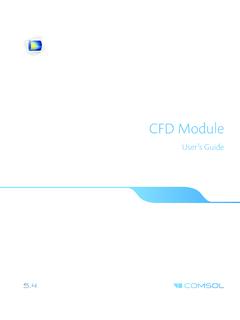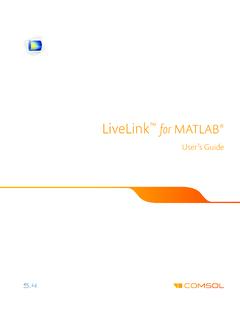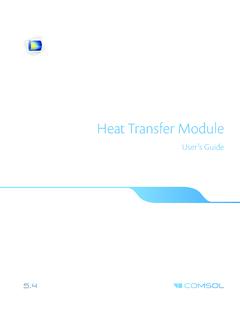Transcription of The CFD Module User’s Guide - COMSOL Multiphysics
1 CFD Module User's Guide CFD Module User's Guide 1998 2017 COMSOL . Protected by Patents listed on , and Patents 7,519,518; 7,596,474;. 7,623,991; 8,457,932; 8,954,302; 9,098,106; 9,146,652; 9,323,503; 9,372,673; and 9,454,625. Patents pending. This Documentation and the Programs described herein are furnished under the COMSOL Software License Agreement ( ) and may be used or copied only under the terms of the license agreement. COMSOL , the COMSOL logo, COMSOL Multiphysics , Capture the Concept, COMSOL Desktop, LiveLink, and COMSOL Server are either registered trademarks or trademarks of COMSOL AB. All other trademarks are the property of their respective owners, and COMSOL AB and its subsidiaries and products are not affiliated with, endorsed by, sponsored by, or supported by those trademark owners. For a list of such trademark owners, see Version: COMSOL Contact Information Visit the Contact COMSOL page at to submit general inquiries, contact Technical Support, or search for an address and phone number.
2 You can also visit the Worldwide Sales Offices page at for address and contact information. If you need to contact Support, an online request form is located at the COMSOL Access page at Other useful links include: Support Center: Product Download: Product Updates: COMSOL Blog: Discussion Forum: Events: COMSOL Video Gallery: Support Knowledge Base: Part number: CM021301. C o n t e n t s Chapter 1: Introduction About the CFD Module 20. Why CFD is Important for Modeling .. 20. How the CFD Module Helps Improve Your Modeling .. 21. Where Do I Access the Documentation and Application Libraries? .. 22. Overview of the User's Guide 26. Chapter 2: Quick Start Guide Modeling and Simulations of Fluid Flow 30. Modeling Strategy .. 30. Geometric Complexities .. 31. Material Properties .. 31. Defining the Physics Interfaces and Features .. 32. Meshing .. 33. The Choice of Solver and Solver Settings.. 34. The CFD Module Physics Interface Guide .. 35.
3 Common Physics Interface and Feature Settings and Nodes.. 42. The Liquids and Gases Materials Database .. 42. Chapter 3: Single-Phase Flow Interfaces Modeling Single-Phase Flow 44. Selecting the Right Physics Interface.. 44. The Single-Phase Flow Interface Options .. 45. Coupling to Other Physics Interfaces .. 49. The Creeping Flow, Laminar Flow, and Turbulent Flow CONTENTS |3. Interfaces 50. The Creeping Flow Interface .. 50. The Laminar Flow Interface .. 51. The Turbulent Flow, Algebraic yPlus Interface .. 56. The Turbulent Flow, L-VEL Interface .. 58. The Turbulent Flow, k- Interface .. 59. The Turbulent Flow, k- Interface .. 61. The Turbulent Flow, SST Interface .. 63. The Turbulent Flow, Low Re k- Interface .. 64. The Turbulent Flow, Spalart-Allmaras Interface .. 66. The Turbulent Flow, v2-f Interface .. 67. Domain, Boundary, Pair, and Point Nodes for Single-Phase Flow .. 70. Fluid Properties .. 70. Volume Force .. 73. Initial Values.
4 73. Wall.. 74. Inlet .. 77. Outlet .. 83. Symmetry .. 84. Open Boundary .. 85. Boundary Stress .. 86. Screen .. 88. Vacuum Pump .. 89. Periodic Flow Condition .. 90. Fan .. 91. Interior Fan .. 93. Interior Wall .. 94. Grille .. 96. Pipe Connection .. 97. Flow Continuity .. 97. Pressure Point Constraint .. 97. Point Mass Source .. 98. Line Mass Source .. 99. Generate New Turbulence Model Interface .. 100. Gravity .. 101. The Rotating Machinery, Laminar and Turbulent Flow 4 | CONTENTS. Interfaces 102. The Rotating Machinery, Laminar Flow Interface .. 102. The Rotating Machinery, Turbulent Flow, Algebraic yPlus Interface .. 104. The Rotating Machinery, Turbulent Flow, L-VEL Interface.. 105. The Rotating Machinery, Turbulent Flow, k- Interface .. 106. Domain, Boundary, Point, and Pair Nodes for the Rotating Machinery Interfaces .. 107. Initial Values.. 108. Rotating Domain .. 108. Wall.. 109. Interior Wall .. 113. Rotating Wall .. 114. Rotating Interior Wall.
5 114. Stationary Free Surface .. 115. Contact Angle .. 116. Theory for the Single-Phase Flow Interfaces 117. General Single-Phase Flow Theory .. 118. Compressible Flow .. 120. Weakly Compressible Flow .. 120. The Mach Number Limit .. 121. Incompressible Flow .. 122. The Reynolds Number.. 122. Non-Newtonian Flow: The Power Law and the Carreau Model .. 123. Gravity .. 124. The Boussinesq Approximation .. 127. Theory for the Wall Boundary Condition .. 128. Prescribing Inlet and Outlet Conditions .. 131. Laminar Inflow .. 133. Laminar Outflow .. 133. Mass Flow .. 134. No Viscous Stress .. 135. Normal Stress Boundary Condition .. 136. Pressure Boundary Condition .. 136. Vacuum Pump Boundary Condition .. 138. Fan Defined on an Interior Boundary .. 139. Fan and Grille Boundary Conditions .. 141. Screen Boundary Condition.. 144. CONTENTS |5. Mass Sources for Fluid Flow.. 146. Numerical Stability Stabilization Techniques for Fluid Flow .. 148. Solvers for Laminar Flow.
6 150. Pseudo Time Stepping for Laminar Flow Models .. 152. The Projection Method for the Navier-Stokes Equations .. 153. Discontinuous Galerkin Formulation .. 155. Particle Tracing in Fluid Flow .. 155. References for the Single-Phase Flow, Laminar Flow Interfaces.. 156. Theory for the Turbulent Flow Interfaces 158. Turbulence Modeling .. 158. The Algebraic yPlus Turbulence Model.. 162. The L-VEL Turbulence Model .. 166. The k- Turbulence Model .. 168. The k- Turbulence Model .. 174. The SST Turbulence Model .. 179. The Low Reynolds Number k- Turbulence Model .. 182. The Spalart-Allmaras Turbulence Model .. 186. The v2-f Turbulence Model .. 189. Inlet Values for the Turbulence Length Scale and Turbulent Intensity .. 194. Theory for the Pressure, No Viscous Stress Boundary Condition .. 195. Initial Values for Generate New Turbulence Model Interfaces .. 196. Solvers for Turbulent Flow .. 198. Pseudo Time Stepping for Turbulent Flow Models.
7 199. References for the Single-Phase Flow, Turbulent Flow Interfaces .. 199. Theory for the Rotating Machinery Interfaces 202. Frozen Rotor .. 203. Setting Up a Rotating Machinery Model .. 205. References .. 206. C h a p t e r 4 : H e a t Tr a n s f e r a n d N o n i s o t h e r m a l F l ow 6 | CONTENTS. Interfaces Modeling Heat Transfer in the CFD Module 208. Selecting the Right Physics Interface.. 208. Coupling to Other Physics Interfaces .. 210. The Nonisothermal Flow and Conjugate Heat Transfer, Laminar Flow and Turbulent Flow Interfaces 212. Advantages of Using the Multiphysics Interfaces .. 212. The Nonisothermal Flow, Laminar Flow and Turbulent Flow Interfaces .. 213. The Conjugate Heat Transfer, Laminar Flow and Turbulent Flow Interfaces .. 213. Settings for Physics Interfaces and Coupling Features .. 214. Coupling Features .. 215. Physics Interface Features .. 215. Nonisothermal Flow .. 217. Flow Coupling .. 221. Marangoni Effect.
8 222. Theory for the Nonisothermal Flow and Conjugate Heat Transfer Interfaces 225. The Nonisothermal Flow and Conjugate Heat Transfer Equations .. 225. Turbulent Nonisothermal Flow Theory .. 227. Theory for the Nonisothermal Screen Boundary Condition .. 232. Theory for the Interior Fan Boundary Condition .. 232. References for the Nonisothermal Flow and Conjugate Heat Transfer Interfaces .. 233. Chapter 5: Multiphase Flow Interfaces Modeling Multiphase Flow 236. Selecting the Right Physics Interface.. 236. The Multiphase Flow Interface Options .. 237. The Relationship Between the Physics Interfaces .. 237. CONTENTS |7. Coupling to Other Physics Interfaces .. 241. The Two-Phase Flow, Level Set and Phase Field Interfaces 242. The Laminar Two-Phase Flow, Level Set Interface .. 242. The Turbulent Two-Phase Flow, Level Set Interface .. 243. Two-Phase Flow, Level Set Coupling Features .. 244. The Wetted Wall Coupling Feature .. 246. The Laminar Two-Phase Flow, Phase Field Interface.
9 248. The Turbulent Two-Phase Flow, Phase Field Interface .. 249. The Two-Phase Flow, Phase Field Coupling Features .. 250. Domain, Boundary, Point, and Pair Nodes for the Laminar and Turbulent Flow, Two-Phase, Level Set and Phase Field Interfaces.. 252. The Three-Phase Flow, Phase Field Interface 254. The Laminar Three-Phase Flow, Phase Field Interface .. 254. The Three-Phase Flow, Phase Field Coupling Feature .. 255. Domain, Boundary, Point, and Pair Nodes for the Laminar Three-Phase Flow, Phase Field Interface .. 256. The Bubbly Flow Interfaces 258. The Laminar Bubbly Flow Interface .. 258. The Turbulent Bubbly Flow Interface .. 260. Domain and Boundary Nodes for the Laminar and Turbulent Bubbly Flow Interfaces .. 262. Fluid Properties .. 264. Gravity .. 266. Mass Transfer .. 266. Initial Values.. 267. Wall.. 267. Inlet .. 269. Outlet .. 271. Symmetry .. 272. Gas Boundary Condition Equations .. 273. The Mixture Model Interfaces 274.
10 The Mixture Model, Laminar Flow Interface.. 274. The Mixture Model, Turbulent Flow Interface .. 277. Domain and Boundary Nodes for the Mixture Model Laminar and 8 | CONTENTS. Turbulent Flow Interfaces .. 279. Mixture Properties .. 280. Initial Values.. 283. Wall.. 283. Mass Transfer .. 285. Gravity .. 286. Inlet .. 287. Outlet .. 288. Symmetry .. 289. The Euler-Euler Model Interfaces 290. The Euler-Euler Model, Laminar Flow interface .. 290. The Euler-Euler Model, Turbulent Flow Interface .. 293. Domain, Boundary, Point, and Pair Nodes for the Euler-Euler Model Interfaces .. 295. Phase Properties .. 295. Initial Values.. 297. Wall.. 298. Inlet .. 299. Outlet .. 301. Gravity .. 302. Volume Force .. 302. Theory for the Two-Phase Flow Interfaces 303. Level Set and Phase Field Equations .. 303. Conservative and Nonconservative Formulations .. 306. Phase Initialization .. 306. Numerical Stabilization .. 308. References for the Level Set and Phase Field Interfaces.










